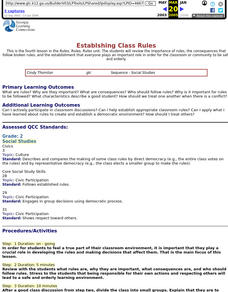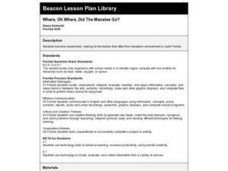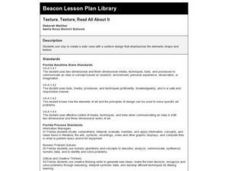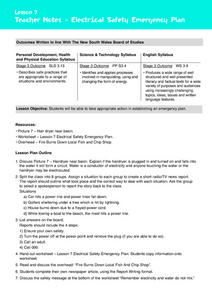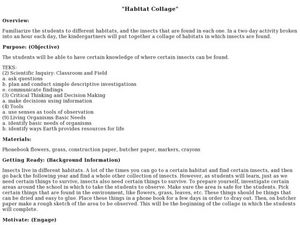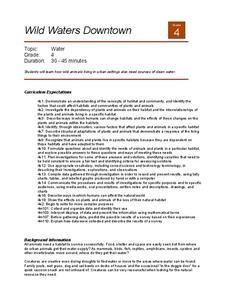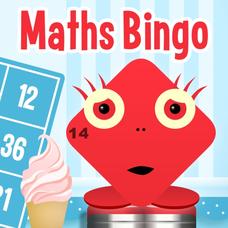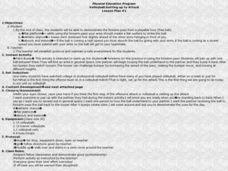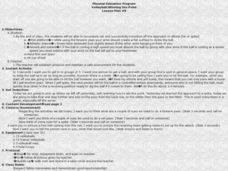Curated OER
Theatre Prop Design and Construction
Fourth graders construct individual props. In this theatrical arts lesson, 4th graders use the elements of art to create various props using paper mache. Students construct objects such as logs, fruit, and a picture frame.
Curated OER
Designs for Urban Life
Students analyze the design of cities and systems as an architecture analysis. In this architecture analysis lesson, students complete image based discussion and two related activities for the lesson.
Curated OER
Save That Water
Students investigate water conservation. In this environmental lesson, students brainstorm ways they use water and discuss ways to conserve water. Students illustrate and write about their method of water conservation.
Curated OER
Establshing Class Rules
Second graders review the importance of rules, the consequences that follow broken rules, and the establishment that everyone plays an important role in order for the classroom or community to be safe and orderly.
Curated OER
EcoTravel Log
Students keep travel record over time, analyze data collected and use the information to identify ways in which they can change their behavior to benefit their health and the environment.
Curated OER
Where, Oh Where, Did The Manatee Go?
Third graders become researchers, looking for the factors that affect the manatee's environment in south Florida.
Curated OER
Texture, Texture, Read All About It
Fourth graders use clay to create a slab vase with a surface design that emphasizes the elements shape and texture. They complete a self-evaluation of their project which is imbedded in this plan.
Curated OER
Brown Bag It
Fourth graders draw an object relying only on their sense of touch and imagination and then draw it again using their powers of observation to create a detailed study of the object. Comparisons are then made of the two drawings.
Curated OER
Mondrian and Matisse: Combining Styles
Fourth graders create artwork using the pure elements of line, shape, and color as the subject matter. The artwork is then cut or torn into organic shapes which are then glued onto a background paper, leaving areas of paper showing in...
Curated OER
Electrical Safety Emergency Plan
Students discuss Picture 7 which is a hairdryer near a basin. They discover that if the hairdryer is plugged in and turned on and falls into the water it will form a circuit and anyone touching the water or hairdryer may be electrocuted....
Curated OER
Ocean in a Bottle
Students create an enclosed ocean in a bottle and add different pollutants to explore the effects of pollution on the environment.
Curated OER
Rockets on a Shoestring Budgut
Students work together to create rockets on a budget. They discover the limitations that real engineers face when designing and testing their products. They discuss their findings to complete the instructional activity.
Curated OER
Wild Waters Downtown
Fourth graders investigate how wild animals living in urba settings also need sources of clean water. They discuss the open water issues of West Nile Virus and what happens to urba animals as these poolings area are cleaned up. ...
Virginia Department of Education
Safety and the Material Safety Data Sheet
While many chemicals are used in biology class, many pupils don't understand the material safety data sheets. The lesson explains each part and the importance of understanding the forms. Young scientists use safety equipment to ensure...
Teach Engineering
Force on a Current Carrying Wire
What do electrical currents have to do with an MRI? Using a simple wire setup and a magnet, class members explore forces used in an MRI by investigating the magnetic force acting on a wire carrying a current.
Teach Engineering
Slinkies as Solenoids
What does an MRI machine have to do with a slinky? This activity challenges learners to run a current through a slinky and use a magnetic field sensor to measure the magnetic field. Groups then change the length of the slinky to see...
Key Stage Fun
Squeebles Maths Bingo
The math monster has scared away all the ice cream parlor's customers and taken the ice cream ingredients. Only an accomplished math bingo player can save this ice cream business.
Curated OER
Volleyball - Lesson 1 - Setting up to Attack
The most important skill to learn in volleyball is passing and bumping. This skill should be practiced every day. The first lesson plan in this unit of twenty lessons is all about passing. Get a good foundation going and learn how to...
Curated OER
Volleyball - Lesson 2 - Setting up to Attack
The focus in lesson two of this 20 lesson volleyball unit is learning how to bump pass. The key to playing volleyball well is for everyone to be able to make good bump passes. It is the first skill used to set up an attack. Pass, set,...
Curated OER
Volleyball - Lesson 6 - Forearm Pass
Feet to the ball, belly button to the target, flat platform. These are the three main cues for making a good forearm pass in volleyball. Teach these cues, practice these skills, work on performing a good forearm pass. Yes, practice,...
Curated OER
Volleyball - Lesson 7 - Setting up the Attack
Lesson seven out of this 20 lesson unit focuses on setting up to attack. There is a lot to consider and know with regard to attacking to score a point. This piece focuses on passing the ball to the setter, who then focuses on setting the...
Curated OER
Volleyball - Lesson 9 - Winning the Point
Pass, set, spike! Putting all these skills together and running some practice drills is what instructional activity 9 is all about. It's not as easy as it sounds. Passing with accuracy, setting where the hitter can spike, timing the hit....
Curated OER
Volleyball: Winning the Point - Lesson 10
Volleyball - Lesson 10 focuses on how to handle a free ball. What does the passer do? What does the setter do? What does the hitter do? These skills are covered in this lesson. Then the class practices in small groups. This lesson is the...





